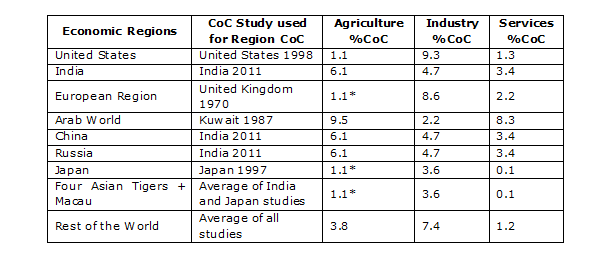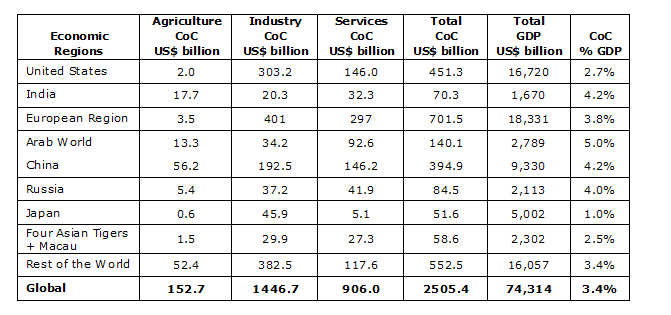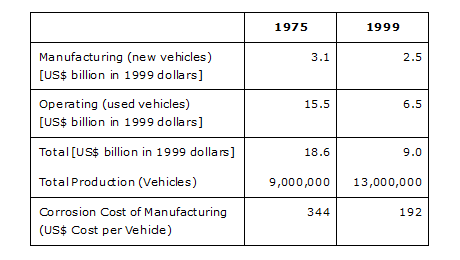Economic Impact
The purpose of the cost-of-corrosion portion of the IMPACT study is to establish an estimate for the cost of corrosion at a global level utilizing past studies. The current study did not attempt to collect new data or perform any new cost of corrosion analysis beyond using publicly available studies to estimate a global cost of corrosion. Therefore, the cost of corrosion performed within the IMPACT study is limited by the completeness and number of available studies. Appendix A contains the detailed global corrosion assessment.
ASSESSMENT OF THE GLOBAL COST OF CORROSION
The global cost of corrosion is estimated to be US$2.5 trillion, which is equivalent to 3.4% of the global GDP (2013). By using available corrosion control practices, it is estimated that savings of between 15 and 35% of the cost of corrosion could be realized; i.e., between US$375 and $875 billion annually on a global basis. These costs typically do not include individual safety or environmental consequences. Through near misses, incidents, forced shutdowns (outages), accidents, etc., several industries have come to realize that lack of corrosion management can be very costly and that, through proper corrosion management, significant cost savings can be achieved over the lifetime of an asset. To achieve the full extent of these savings, corrosion management and its integration into an organization’s management system must be accomplished by implementing a Corrosion Management System (CMS).
Since the 1950s several countries considered the economic consequences of corrosion. Studies conducted during this time indicated that the cost of corrosion to society was significant. The different approaches used to arrive at this cost included:
The Uhlig method, which defines corrosion cost as the total expenditure by manufacturing industries and corrosion-protection measures.
The Hoar method, which estimates corrosion costs for individual industrial sectors, taking into account both direct corrosion cost and spending on countermeasures. In addition to operational costs, the cost of capital can also be included.
The input/output economic model, used in the 1970s Battelle study, which uses domestic commercial interactions among industries.
To relate the cost of corrosion studies to a global cost of corrosion, a relationship between economic sectors and corrosion costs is needed. Furthermore, the GDP of the economic sectors by country must be known to permit the use of the “percent cost of corrosion by economic sector” within the extrapolation to global corrosion costs.
The studies that were included in the IMPACT study were: India 2011-2012, United States 1998, Japan 1997, Kuwait 1987, and United Kingdom 1970. Each of these studies provided data that could be mapped to the three economic sectors: (1) Agriculture, (2) Industry, and (3) Services. Throughout the global cost of corrosion analysis, the World Bank economic sector and GDP data were utilized.
The economic breakdown for the five countries used in this analysis is shown in Figure 2-1. The United States, United Kingdom, and Japan, with advanced industrial and service economies, are very similar; whereas India, with a significant agricultural economy, and Kuwait, with a significant oil industry, have different profiles. In order to address the economic sectors for different parts of the world, the global economy was divided into economic regions with similar economies (according to World Bank). These were: United States, India, European Region, Arab World (as defined by the World Bank), China, Russia, Japan, Four Asian Tigers+Macau, and Rest of the World. Countries included in each region are provided in Appendix A.

Figure 2-1. Economic Sectors for the five countries used in the
Global Cost of Corrosion Study.
The global cost of corrosion was assessed by mapping the five available studies to the nine economic regions using Table 2-1. Note that as additional cost of corrosion studies become available, or studies are updated, more detailed and accurate global costs can be assessed.

Table 2-1. Map of Cost of Corrosion Studies to Economic Regions
Using Table 2-1 and the GDP for each region divided by economic sector, the cost of corrosion for each country by sector and the total cost of corrosion for each country was determined. The global cost of corrosion is then determined for each economic region by sector by summing the countries in the region (see Table 2-2). The global cost of corrosion is estimated to be US$2,505 billion, which is equivalent to 3.4% of the global GDP (2013). In addition, these costs typically do not include individual safety or environmental consequences. The costs associated with safety and environmental consequences may be difficult to include in an individual country or global cost of corrosion study, but these costs should be considered in an overall management system cost of corrosion for the purpose of decision making and prioritizing projects to be completed within a specific company/corporation.
The above global cost of corrosion is based on available studies that had sufficient sector detail for a global sector analysis to be performed. Previous cost of corrosion studies indicated that between 15 and 35% of the cost of corrosion could be saved by using current available corrosion control practices; i.e., between US$375 and $875 billion globally. The fact that corrosion control can be profitable has been realized over and over again by industry, often following costly business interruptions due to failures of equipment and assets to perform as intended. Cost savings from corrosion control are often not obvious for some period of time; i.e., (i) maintenance costs slowly decrease; (ii) monitoring or inspection costs decrease or inspection intervals increase; (iii) fewer failures save lost production time and/or lost product, decrease injuries, decrease property damage, decrease environmental releases, and improve public relations; and (iv) life extension of the asset. All of these can be included in the business case for enhanced corrosion management. Achieving the most benefit from corrosion control practices is dependent on good business decisions. Therefore, to achieve the full extent of these savings, corrosion management and its integration into an organization’s management system must be accomplished by implementing a CMS as outlined in the Corrosion Management System Framework.
Table 2-2. Global Cost of Corrosion by Region by Sector (Billion US$ 2013)

There are problems with using the existing studies to examine savings over time due to implementation of corrosion control practices. For instance, in the United States the cost of corrosion has been estimated to be equivalent to 2.5% of the GDP in 1949 (Uhlig method), 4.5% of the GDP in 1975 (input/output method), and 3.1%of the GDP in 1998 (Hoar method). The problem is that in general, the studies use different analyses to estimate the cost of corrosion so a direct comparison is not possible. As discussed in Chapter 4, corrosion measures are not well defined or consistently used within the industry as a whole.
One of the most significant success stories in corrosion management is the change in corrosion management strategy and application of innovative technology in the automotive industry. This was a global change involving all of the top manufacturers. Since 1975, the manufacturers have created a coordinated and balanced effort between advances in design, materials, and processing. The automotive industry has moved from (i) minimal corrosion control where the cost of corrosion was primarily maintenance and loss of capital (the life of an automobile was often determined by the corrosion of the body and frame) to (ii) state-of-the-art corrosion control through advanced painting/coating technology and use of corrosion-resistant materials, resulting in competitive advantages and warranties against corrosion.
Note that the cost benefit of this transformation is difficult to estimate because different methods were used to provide costs, making the uncertainty of the costs high. Table 2-3 provides the costs available from the two cost of corrosion studies performed in the U.S. that included automotive costs.2-3 In 1975, it was estimated that the annual cost of corrosion in the automotive industry was US$6.0 billion, which when adjusted for inflation is equivalent to US$18.6 billion in 1991 dollars (see Table 2-3 for a breakdown of the costs into manufacturing (new car costs) and operating (used car costs). In 1999 the estimated annual cost of corrosion in the automotive industry was US$23.4 billion. The cost of depreciation was 61% of the 1999 cost and was not included in the 1975 study, such that discounting depreciation, the 1975 cost would be unchanged at US$18.6 billion compared to US$9.0 billion in 1999. Thereby, the transition in corrosion management strategy produced an annual savings in 1999 compared to 1975 of US$9.6 billion or 52% in corrosion-related manufacturing and operation costs of vehicles. The new vehicle cost of corrosion per unit also decreased by 44% in 1999 compared to 1975. Furthermore, the average age of vehicles increased from 1975 to 1999 by 49%, providing an additional significant benefit to consumers.
Global motor vehicle production in 1999 was 56.2 million, or 4.3 times the U.S. production. If the U.S. production is indicative of corrosion related costs globally, the annual cost savings in 1999 compared to 1975 would be US$41.3 billion.
Table 2-3. Corrosion-Related Costs in the Automotive Industry

This transformation in corrosion management strategy by the automotive industry was a decision at the highest levels of an organization, resulting in lower corrosion-related manufacturing costs, lower corrosion-related operating costs, and longer life of automobiles for the buying public.
Maximizing savings due to the impact of corrosion will only be realized by the incorporation of sound corrosion management practices throughout the organization. In the remainder of the IMPACT study, corrosion management is discussed and a corrosion management system is detailed that, if implemented, would permit a significant portion of these savings to be realized.